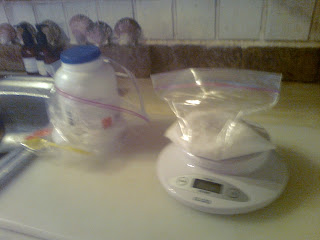- 1000 grams olive oil
- 178 grams lye
- 330 grams water
(1) I weighed out the lye. I kept it in a plastic bag so that there would be one less caustic thing to wash afterwards.
(2) I measured my distilled water into a glass pyrex measuring cup.
(4) You see, below, my preparations for mixing the lye into the water (nb, it is always the lye into the water to avoid any splashing).
(5) Here is the oil, heating up in the pan.
(6) Now, the oil is hot and the lye water has created its magic chemical reaction. As they both cool to about the same 100 degrees Fahrenheit, they are mixed together. Getting them to within 10 degrees of the same temperature can be trickier than it sounds, so letting the containers sit in either a cold or hot water bath might help.
(7) Using my magic wand, I beat the mixture until it is solid enough that a trace of soap is left on the top when I swirl.
(8) Molds are filled.
(9) Molds tops are covered with Saran wrap and wrapped in a towel for 24 hours.



















